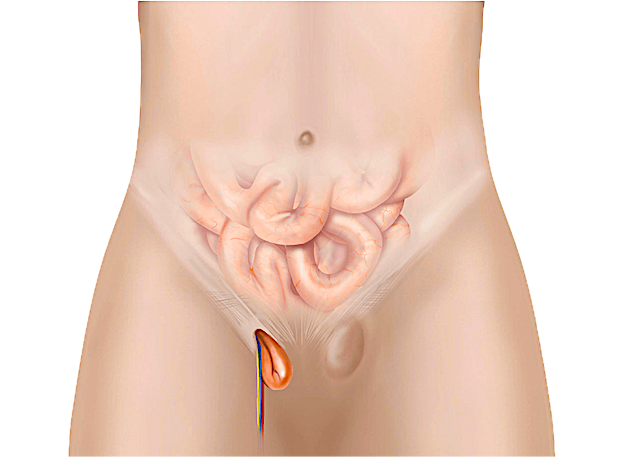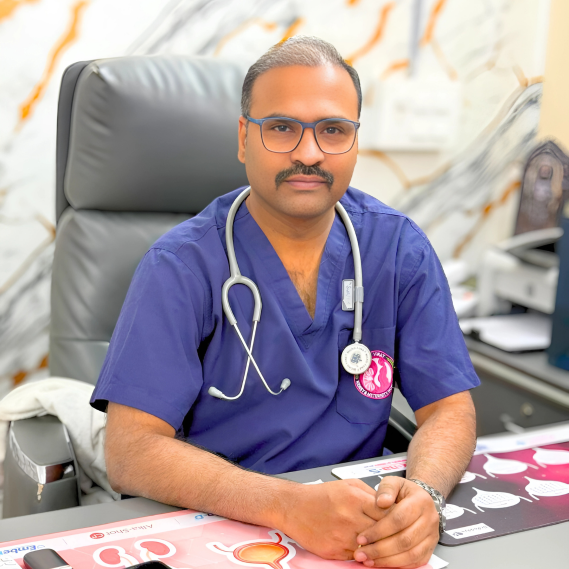Are you suffering from an inguinal hernia and looking for the best possible treatment? At KK Virat Hospital, Karimnagar, we offer advanced laparoscopic hernia repair for a swift recovery with minimal discomfort. Our expert surgeons use the latest techniques to provide effective, safe, and minimally invasive hernia treatment.
What is an Inguinal Hernia?
An inguinal hernia occurs when a portion of the intestine or other abdominal tissue protrudes through a weak spot in the abdominal wall near the groin. This condition results in a visible lump or bulge, which can cause discomfort, especially when coughing, bending, or lifting heavy objects. Men are more commonly affected by inguinal hernias, and surgery is often necessary to prevent complications.

Types of Inguinal Hernia
1. Indirect Inguinal Hernia
- Occurs when abdominal contents push into the inguinal canal.
- More common in children and young adults.
- Often congenital but can develop later due to heavy lifting or straining.
2. Direct Inguinal Hernia
- Happens when tissue protrudes through a weak spot in the abdominal wall.
- More common in older men due to muscle weakening over time.
Risk Factors for Inguinal Hernia
Several factors can increase the risk of developing an inguinal hernia, including:
- Previous Surgeries: Previous abdominal surgeries can weaken muscle tissues.
- Age: Muscle tissues weaken with ageing.
- Gender: Men are more likely to develop inguinal hernias.
- Family History: Genetic predisposition can play a role.
- Smoking: Can lead to chronic coughing, increasing hernia risk.
- Obesity: Excess weight puts pressure on abdominal muscles.
- Heavy Lifting: Repeatedly lifting heavy objects can strain the abdomen.
- Chronic Constipation: Straining during bowel movements increases pressure on the abdominal wall.
Diagnosis of Inguinal Hernia
A hernia diagnosis involves:
- Physical Examination: The doctor checks for a visible bulge.
- Ultrasound: Non-invasive imaging to confirm the hernia.
- CT Scan or MRI: Provides detailed internal images.
- Blood Tests: To check for infection or complications.
Treatment for Inguinal Hernia
Non-Surgical Management (Temporary Relief)
- Pain Management: Pain relievers and stool softeners can ease symptoms.
- Lifestyle Modifications:
- Maintain a healthy weight.
- Eat a high-fiber diet to prevent constipation.
- Avoid straining or heavy lifting.
- Hernia Belts (Truss): Provides temporary support but is not a permanent solution.
Surgical Treatment for Inguinal Hernia
Surgery is the only permanent solution for an inguinal hernia. Two main surgical options include:
1. Open Hernia Repair (Herniorrhaphy)
- A single large incision is made in the groin.
- The hernia sac is repositioned into the abdomen.
- The weakened area is reinforced with sutures or mesh.
- Requires a longer recovery period than laparoscopic surgery.
2. Laparoscopic Hernia Repair (Minimally Invasive Surgery)
- Faster recovery, less pain, and smaller scars than open surgery.
- Three small incisions are made in the abdomen.
- A laparoscope (camera) guides the procedure.
- The hernia is repaired with mesh reinforcement.
Why Laparoscopic Surgery is the Best Choice
Laparoscopic hernia repair is the preferred method due to:
- Ability to treat multiple hernias at once.
- Smaller incisions and less scarring.
- Quicker recovery time.
- Lower risk of infection.
- Less postoperative pain and discomfort.
Preparing for Inguinal Hernia Surgery
To ensure a smooth surgical experience:
- Follow pre-surgery fasting guidelines.
- Arrange transportation and post-surgery care.
- Stop smoking and alcohol consumption.
- Inform your doctor about the medications you are taking.
- Avoid blood thinners and aspirin before surgery.
Recovery After Inguinal Hernia Laparoscopic Surgery
Most patients can resume normal activities within a week, but full recovery takes about 4-6 weeks. Follow these recovery tips:
- Attend follow-up appointments.
- Rest and avoid strenuous activities.
- Take prescribed pain medications as needed.
- Eat a fibre-rich diet to prevent constipation.
- Keep the surgical area clean and dry.
Potential Risks and Complications
While laparoscopic surgery is safe and effective, potential risks include:
- Infection at the incision site.
- Hernia recurrence (rare with proper care).
- Temporary swelling or bruising.
- Mesh-related complications (extremely rare).
- Nerve damage (minor and uncommon).
Why Choose KK Virat Hospital for Inguinal Hernia Treatment?
- Expert Laparoscopic Surgeons: Highly experienced in hernia repairs.
- State-of-the-Art Facilities: Advanced technology for precise procedures.
- Faster Recovery & Minimal Scarring: Compared to traditional surgery.
- Comprehensive Post-Surgical Care: Ensuring safe recovery.
Your Health, Our Priority – Book Your Consultation Today!
Don’t let an inguinal hernia affect your quality of life. Visit KK Virat Hospital, Karimnagar, for expert diagnosis and laparoscopic hernia surgery. Contact us now to schedule your appointment!
- Call Us Directly: Get in touch with our medical coordinators to schedule an appointment with an expert urologist.
- Direct Visit: You can visit our hospital directly by carrying your previous medical records if you have a medical history. However, admission will be based on the doctor’s recommendation.
Is laparoscopic inguinal hernia surgery safe?
Yes, laparoscopic surgery is safe and highly effective, with a low risk of complications. It offers faster recovery, minimal pain, and reduced infection risk compared to open surgery.
What can cause pain in the inguinal area in males?
Pain in the inguinal region can be due to inguinal hernia, muscle strain, nerve compression, infections, or testicular conditions. A proper medical evaluation can determine the exact cause.
What role does patient history play in the differential diagnosis process for inguinal hernias?
A patient’s history helps identify symptoms, risk factors, and previous conditions, aiding in the accurate diagnosis and differentiation of hernias from other conditions like groin strain or lymph node swelling.
How can I differentiate between a hernia and other causes of pain in the inguinal area in females?
Hernias usually present with a visible or palpable bulge, which increases with activity. Other conditions, such as ovarian cysts, muscle strain, or infections, may cause similar pain without a bulge.
What are the various types of mesh used for inguinal hernia repair?
Meshes used in hernia repair include synthetic meshes (polypropylene, polyester) and biologic meshes. Synthetic mesh is commonly used due to its durability and low recurrence rate.
Is surgery the primary treatment for direct inguinal hernia?
Yes, surgery is the only definitive treatment for a direct inguinal hernia. Without surgery, the hernia may enlarge, causing pain, discomfort, or complications like strangulation.
What are the dos and don’ts to follow after inguinal hernia surgery?
- Do: Follow a healthy diet, walk regularly, keep the incision clean, and attend follow-ups.
- Don’t: Lift heavy objects, strain during bowel movements, or engage in strenuous activities too soon.
How long does the surgery of an indirect inguinal hernia typically take?
Laparoscopic inguinal hernia surgery usually takes 30-60 minutes, depending on the complexity of the hernia.
Can strangulated inguinal hernias lead to long-term complications if left untreated?
Yes, a strangulated hernia is a medical emergency that can cause severe infection, tissue death, and life-threatening complications if not treated immediately.
What is the recovery time after bilateral inguinal hernia treatment?
Recovery from bilateral laparoscopic hernia repair typically takes 2-3 weeks, with full recovery in 4-6 weeks.


